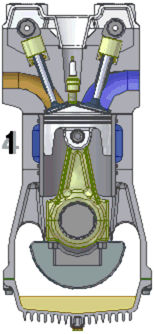|
|
| Visit this group |
A petrol engine (known as a gasoline engine in North America) is an internal combustion engine with spark-ignition, designed to run on petrol (gasoline) and similar volatile fuels.
It differs from a diesel engine in the method of mixing the fuel and air, and in the fact that it uses spark plugs to initiate the combustion process. In a diesel engine, only air is compressed (and therefore heated), and the fuel is injected into the now very hot air at the end of the compression stroke, and self-ignites. In a petrol engine, the fuel and air are usually pre-mixed before compression (although some modern petrol engines now utilise cylinder-direct petrol injection). The pre-mixing was formerly done in a carburetor, but now (except in the smallest engines) it is done by electronically-controlled fuel injection. Pre-mixing of fuel and air allows a petrol engine to run at a much higher speed than a diesel, but severely limits their compression, and thus efficiency
The first fast-running petrol engine was invented by the German automobile pioneer Gottlieb Daimler.
Applications
Petrol engines have many applications, including:
- Motor cars
- Motorcycles
- Aircraft
- Motorboats
- Small machines, such as lawn mowers, chainsaws and portable engine-generators
Design
Working cycles
Petrol engines may run on the four-stroke cycle or the two-stroke cycle. For details of working cycles see:
Cylinder arrangement
Common cylinder arrangements are from 1 to 6 cylinders in-line or from 2 to 16 cylinders in V-formation. Flat engines -- like a V design flattened out-- are common in small airplanes and motorcycles and were a hallmark of Volkswagen automobiles into the 1990s. Flat 6s are still used in many modern Porsches, as well as Suburus. Many flat engines are air-cooled. Less common, but notable in vehicles designed for high speeds is the W formation, similar to having 2 V engines side by side. Alternatives include rotary and radial engines the latter typically have 7 or 9 cylinders in a single ring, or 10 or 14 cylinders in two rings.
Cooling
Petrol engines may be air-cooled, with fins (to increase the surface area on the cylinders) and cylinder head; or liquid-cooled, by a water jacket and radiator. The coolant was formerly water, but is now usually a mixture of water and ethylene glycol. This mixture has a lower freezing-point and a higher boiling-point than pure water, and also prevents corrosion, with modern antifreezes also containing lubricants and other additives to protect water pump seals and bearings. The cooling system is usually slightly pressurised to raise the boiling point of the coolant.
Compression ratio
The compression ratio is the ratio between the total volumes of the cylinder AND the combustion chambers - at the beginning, and end of the compression stroke. Broadly speaking, the higher the compression ratio, the higher the efficiency of the engine. However, compression ratio has to be limited to avoid pre-ignition of the fuel-air mixture which would cause engine knocking and damage to the engine. Modern motor-car engine generally have compression ratios of between 9:1 and 10:1, but this can go up to 11 or 12:1 for high-performance engines that run on higher octane fuel.



